สภาวะที่เหมาะสมในการกัดผิวหน้าเรียบผลิตภัณฑ์วัสดุเชิงประกอบไม้พลาสติก ต่อค่าความขรุขระผิว
คำสำคัญ:
วัสดุเชิงประกอบไม้พลาสติก, ความขรุขระผิว, เครื่องกัดแนวตั้งบทคัดย่อ
งานวิจัยนี้มีวัตถุประสงค์เพื่อศึกษาสภาวะที่เหมาะสมต่อค่าความขรุขระผิวในกระบวนการกัดผลิตภัณฑ์วัสดุเชิงประกอบไม้พลาสติกที่มีขายในเชิงพาณิชย์ โดยมีปัจจัยที่ใช้ในการทดลอง คือ ความเร็วรอบ 250 500 และ 710 รอบ/นาที อัตราป้อนกัด 125 315 และ 630 มม./นาที ความลึกในการกัด 0.50 0.75 และ 1.00 มม. และวัสดุเชิงประกอบชนิดที่มีส่วนผสมหลักระหว่าง PE PP หรือ PVC และผงไม้ จากผลการศึกษาปัจจัยที่ส่งผลต่อค่าความขรุขระผิวของวัสดุเชิงประกอบ PE PP และ PVC พบว่า แนวโน้มค่าความขรุขระผิวระดับต่ำสุดสำหรับวัสดุเชิงประกอบ PP เมื่อทำการปรับค่าความเร็วรอบที่ 500 รอบ/นาที อัตราป้อนกัด 315 มม./นาที และความลึก 0.75 มม. โดยมีค่าความขรุขระผิว 1.70 µm สำหรับวัสดุเชิงประกอบ PE เมื่อปรับค่าความเร็วรอบที่ 710 รอบ/นาที อัตราป้อนกัด 125 มม./นาที และความลึก 1.00 มม. ให้ค่าความขรุขระผิว 2.64 µm และวัสดุเชิงประกอบ PVC เมื่อปรับค่าความเร็วรอบที่ 500 รอบ/นาที อัตราป้อนกัด 125 มม./นาที และความลึก 0.50 มม. ให้ค่าความขรุขระผิว 1.78 µm นอกจากนี้ยังพบว่าชนิดของพลาสติกจะส่งผลต่อความขรุขระผิวของผลิตภัณฑ์ โดยที่วัสดุเชิงประกอบ PP ให้ค่าความขรุขระผิวต่ำสุด รองลงมา คือ วัสดุเชิงประกอบ PVC และ PE ตามลำดับ
References
M. Chaharmahali, M. Tajvidi and S. K. Najafi, “Mechanical properties of wood plastic composite panels made from waste fiberboard and particleboard,” Polymer Composites, vol. 10, no 3, pp. 606-610, 2008. doi: 10.1002/pc.20434.
S. Tamrakar and R. A. Lopez-Anido, “Water absorption of wood polypropylene composite sheet piles and its influence on mechanical properties,” Construction and Building Materials, vol. 25, no. 10, pp. 3977–3988, 2011. doi: 10.1016/j.conbuildmat. 2011.04.031.
S. Sriarkarin, S. Suksard, W. Hoamuangkaew, and S. Jarusombuti, “Marketing of wood plastic composite products in Thailand,” Thai Journal of Forestry, vol 31, no 1, pp. 46–54, 2022.
C. Srivabut, T. Ratanawilai and S. Hiziroglu, “Response surface optimization and statistical analysis of composites made from calcium carbonate filler-added recycled polypropylene and rubberwood fiber,” Journal of Thermoplastic Composites Material, vol 35, no 3, pp. 391–415, 2022, doi: 10.1177/0892705719889988.
N. Ayrilmis, U. Buyuksari and T. Dundar, “Waste pine cones as a source of reinforcing fillers for thermoplastic composites,” Journal of Applied Polymer Science, vol. 117, no. 4, pp. 2324–2330, 2010, doi: 10.1002/app.32076.
R. Z. Huang, B. J. Kim, S. Lee, Z. Yang and Q. L. Wu, “Co-extruded wood-plastic composites with talc-filled shells: morphology, mechanical, and thermal expansion performance,” BioResources, vol. 8, no. 2, pp. 2283–2299, 2013, doi: 10.15376/biores. 8.2.2283-2299.
S. Rimdusit, W. Smittakorn, S. Jittarom and S. Tiptipakorn, “Highly filled polypropylene rubber wood flour composites,” Engineering Journal, vol 15, no. 2, pp. 17–30, 2011, doi: 10.4186/ej.2011.15.2.17.
C. Homkhiew and T. Ratanawilai, “Optimal proportions of composites from polypropylene and rubberwood flour after water immersion using experimental design,” KKU Research Journal, vol. 19, no. 6, pp. 780–793, 2014.
T. Ratanawilaia, P. Pitsuwan, S. Jirasampata and C. Homkhiew, “Influence of Milling Factors on Surface Finish of Wood-Plastic Composites,” Ladkrabang Engineering Journal, vol. 32, pp. 43–48, 2015.
C. Srivabut, S. Rawangwong, C. Homkhiew and J. Rodjananugoon, “Optimal condition on surface roughness in side milling of high-density polyethylene and rubberwood flour composites using response surface methodology,” Ladkrabang Engineering Journal, vol 39, no 1, pp. 23–34, 2022.
E. O. Olakanmi, E. A. Ogunesan, E. Vunain, R. A. Lafia-Araga, M. Doyoyo and R. Meijboom, “Mechanism of fiber/matrix bond and properties of wood polymer composites produced from alkaline-treated daniella oliveri wood flour,” Journal of Polymer Composites, vol. 37, no.9, pp. 2657–2672, 2016, doi: 10.1002/pc.23460
C. Srivabut, C. Homkhiew and S. Rawangwong, “Optimal composition on surface roughness of wood-plastic composites using mixture design and response surface methodology,” Ladkrabang Engineering Journal, vol 38, no 4, pp. 151–165, 2021.
J. Lamaming, R. Hashim, O. Sulaiman, T. Sugimoto, M. Sato and S. Hiziroglu, “Measurement of some properties of binderless particleboards made from young and old oil palm trunks,” Measurement, vol 47, pp. 813–819, 2014. doi: 10.1016/j.measurement.2013.10.007
C. Srivabut, A. T. Kamnerdwam, C. Homkhiew, S. Rawangwong and T. Ratanawilai, “Response Surface Optimization on Flexural Properties of Wood-Plastic Composites for Structure Materials Exposed to High Moisture Content,” The Journal of Industrial Technology, vol 18, no 1, pp. 1–20, 2022, doi: 10.14416/j.ind.tech.2022.02.001
S. Rawangwong and J. Chatthong, “The study favorable conditions for the cutting text on Para wood by computer numerical controlled milling”, in 16th IE Network Conference, Phuket, Thailand, Oct. 24–26, 2007, pp. 121–129.
Z. Hutyrova, J. Zajac, P. Michalik, D. Mital, J. Duplak and S. Gajdos, “Study of surface roughness of machined polymer composite material,” International Journal of Polymer Science, vol. 1, pp. 1–6, 2015, doi: 10.1155/2015/303517
C. Tasdemir, I. H. Basboga and S. Hizirogiu, “Surface Quality of wood plastic composites as function of water exposure,” Applied Sciences, vol. 10, pp.156–167, 2020. doi: 10.3390/app10155122
Wechsler and S. Hiziroglu, “Some of the properties of wood–plastic composites,” Building and Environment, vol. 42, pp.2637–2644, 2007, doi: 10.1016/j.buildenv.2006.06.018
Downloads
เผยแพร่แล้ว
How to Cite
ฉบับ
บท
License
Copyright (c) 2023 คณะวิศวกรรมศาสตร์ สถาบันเทคโนโลยีพระจอมเกล้าเจ้าคุณทหาร

This work is licensed under a Creative Commons Attribution-NonCommercial-NoDerivatives 4.0 International License.
บทความที่ได้รับการตีพิมพ์เป็นลิขสิทธิ์ของคณะวิศวกรรมศาสตร์ สถาบันเทคโนโลยีพระจอมเกล้าเจ้าคุณทหารลาดกระบัง
ข้อความที่ปรากฏในบทความแต่ละเรื่องในวารสารวิชาการเล่มนี้เป็นความคิดเห็นส่วนตัวของผู้เขียนแต่ละท่านไม่เกี่ยวข้องกับสถาบันเทคโนโลยีพระจอมเกล้าเจ้าคุณทหารลาดกระบัง และคณาจารย์ท่านอื่นๆในสถาบันฯ แต่อย่างใด ความรับผิดชอบองค์ประกอบทั้งหมดของบทความแต่ละเรื่องเป็นของผู้เขียนแต่ละท่าน หากมีความผิดพลาดใดๆ ผู้เขียนแต่ละท่านจะรับผิดชอบบทความของตนเองแต่ผู้เดียว






